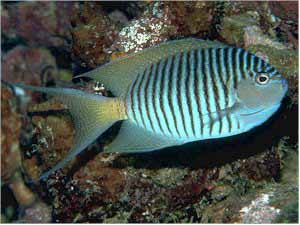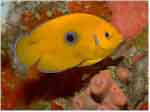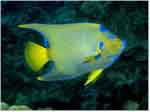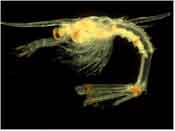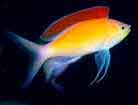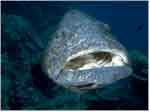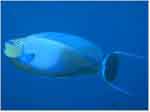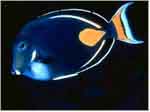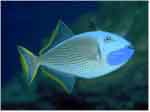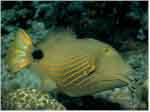|
Planktonivory
among Reef Fishes
This article is written by Andy Lewis of Tevene'i Marine based in Australia. Tevene'i Marine is a Coral Reef Ecology Consultancy and Ecotourism business established by Dr. Andrew Lewis and Daniela Lewis, graduates of the Department of Marine Biology at James Cook University.
Figure 1: (above) Black-spot Angelfish (Genicanthus melanospilos)
Figure 2: (above L) Lemonpeel Angelfish (Centropyge flavissimus); (above R) Queen Angelfish (Holacanthus ciliaris) Biological Background Planktivorous fishes are those that feed primarily on tiny organisms (plankton) found in the water flowing past coral reefs. Plankton are only just visible to the naked eye, and may include crustaceans such copepods and crab larvae (Figure 3), gelatinous creatures such as salps and ctenophores, and even small pieces of dislodged algae from the reef surface.
Figure 3: Crustacean larva. Despite their small size, plankton are extremely abundant in the tropical waters around coral reefs. Hence, they offer a good food source for reef fishes, provided that the fish can overcome a few special problems associated with planktivory. First, fishes need extremely keen eyesight to detect their tiny prey. Second, fishes must have a mouth capable of repeatedly and rapidly ingesting such small prey items. Third, fishes must expose themselves to predators as they rise up into the water current to feed. Now, the intriguing thing about this conundrum, is that representative species from nearly all families of reef fishes have solved these problems in similar ways, and evolved to become planktivores. Typically, this has resulted in fishes with small terminal mouths equipped with protrusible jaws that can extend out from the body to ingest food. Their eyes have also moved closer to the snout, and their retina's may have cone densities greater than 100,000 per mm, giving great visual acuity. Behaviourally, planktivores form large feeding schools to minimise predation risk, and these schools usually aggregate over dense stands of hard coral in areas of high current flow. The fishes swim constantly to maintain position, and allow the water current to sweep plankton to them. To facilitate this feeding behaviour, planktivores have evolved streamlined bodies and large tails. This month's images of angelfishes illustrate this quite well. The main image (Figure 1) shows Genicanthus melanospilos, which feeds on plankton over steep outer reef drop-offs in the Indo-Pacific. You can clearly see that the tail is larger and the body more streamlined than the other species in Figures 2&3, which feed on benthic invertebrates like most other angelfishes. As mentioned, we can find planktivorous representatives from most major families and trophic groups. Some examples are shown below. The family Serranidae contains the groupers and rock cods, which are mainly predators of other fishes, but within the family there are more than 20 species from the genus Pseudanthias which are planktivores.
Figure 4: (left) Pseudanthias dispar; (right) Epinephelus lanceolatus.
Other examples can be found within the herbivorous Acanthuridae (surgeonfishes);
Figure 5: (left) Naso vlamingii (planktivore); (right) Acanthurus achilles.
and the carnivorous Balistidae (triggerfishes).
Figure 6: (left) Xanthichthys auromarginatus (planktivore); (right) Balistapus undulatus.
The planktivorous fishes are an extremely important component of the coral reef ecosystem for several reasons. They are very abundant, and often form the largest proportion of the fish assemblage (in terms of both numbers and biomass) on Indo-Pacific coral reefs. They are also harvesting open water primary production and funneling this energy onto the coral reef, where it is subsequently made available to other trophic groups such as piscivores and detritivores. We hope these images have given you some new insights into the functioning of coral reefs and the role of planktivorous fishes. |
||||||||
|
|
||||||||


